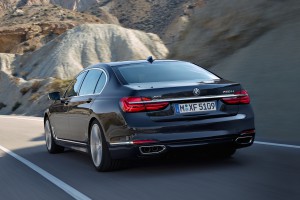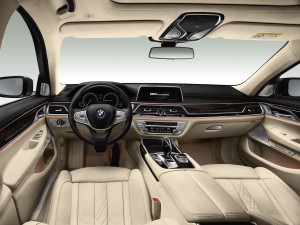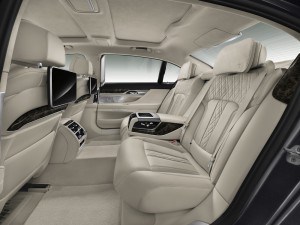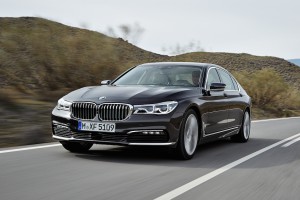This article has been updated with additional information.
There’s likely to be a lot of finger-pointing when the all-new, 2016 BMW 7-Series reaches showrooms in the coming months. And that’s precisely what the Bavarian automaker wants.
Aiming to catch up to the segment-leading Mercedes-Benz S-Class, BMW not only gave the new 7-Series a visual makeover but also is loading it up with a wide array of high-tech comfort, infotainment and safety features. And a number of key commands, such as adjusting the sedan’s volume control, can be handled with a simple gesture.
“Pre-selected hand movements in the vicinity of the center console allow 3D sensors to register and fulfill requested actions. Gestures to adjust the audio volume control, accept or reject incoming phone calls,” BMW explained during a preview of the new model in Germany on Wednesday.
Visually, the new 7-Series isn’t going to surprise those used to the look of the old sedan.

The all-new BMW 7 Series will be offered in the US exclusively as a long wheelbase version, more than one inch longer than its predecessor.
But under the skin the maker has made some significant changes to the sixth-generation 7-Series, starting with the extensive use of carbon fiber, as well as ultra-high-strength steel for key structural components. The doors and trunk lid, meanwhile, are stamped out of aluminum.
BMW has been pushing to take the industry lead when it comes to super-strong, ultra-light carbon fiber, using the material extensively on its battery-based i3 and i7 models. It has entered into a joint venture that is quadrupling the size of a plant in Washington State that will soon become the world’s largest source of carbon fiber.
(New BMW 7-Series spotted before autumn unveiling. For more, Click Here.)
The combination of advanced materials helped BMW shave 190 pounds off the weight of the 2016 7-Series, even though the sedan, in long-wheelbase form, is more than an inch longer than its predecessor, at 206.6 inches. Its wheelbase remains the same, at 124.6 inches, as does its 74.9-inch width.

The standard-Dynamic Digital Instrument Cluster has a 12.3-inch display area, which alters the graphics and color scheme to match the driving mode.
Worldwide, the new 7-Series will be offered with a variety of different powertrains. Initially, the American version will be offered with either a 3.0-liter V-6 making 320 horsepower in the 740i. The 750i xDrive will be motivated by a twin-turbo 445-hp V-8 putting power to all four wheels. Zero to 60 times are 4.3 seconds for the V-8 and 5.4 seconds for the six-banger.
BMW will add a new plug-in hybrid, as well, the 740e xDrive. The gasoline side of the package is a turbocharged 2.0-liter inline-four, paired with an electric motor. The PHEV will get up to 23 miles in pure electric mode at speeds up to 75 mph.
The engines will be paired with an eight-speed automatic transmission. Even here, the new 7-Series adds some smart technology, pairing the gearbox with the onboard navigation system.
(Click Herefor details about the new BMW X1.)
“The navigation-data- based shift strategy means that the gear selection can be adapted to the driving situation and the route profile even if route guidance has not been set,” explains BMW. “The shift characteristics are adjusted in accordance with the selected driving mode, so that the emphasis can be placed on both driving comfort and sportiness.”
Aerodynamic changes have been integrated into the design to improve both performance and fuel economy. For the first time, the 7-Series will use an active version of the familiar kidney grille that closes when cooling demands are low in order to reduce drag. The 7-Series also gets the Air Breather system to reduce turbulence and drag around the front wheels.

The Luxury Rear Seating package includes rear ventilated seats, heated armrests and a 7-inch Touch Command Tablet provides unrivalled seating comfort.
The premium-luxury sedan segment has suffered from declining sales in recent years and the 7-Series has been particularly hard hit – along with the Audi A8. Mercedes has been able to keep its momentum going with the S-Class remake launched two years ago that set a new benchmark for the segment.
BMW is determined to get back in the game. Among other things, it is targeting the booming Chinese luxury market with new features aimed at buyers who prefer to be chauffeured. A simple touch of a button will send the front passenger seats scooting forward and folding out of the way to give the right rear passenger plenty of legroom. They also can use the pop-up footrest and an optional rear seat that declines to 42.5 degrees.
(To see more about Jaguar working up a second SUV, Click Here.)
On the tech side, the new gesture control system is clearly the big story. The technology is familiar to gamers with such systems as the Microsoft Xbox. How it will work in the automotive environment remains to be seen but BMW seems to believe that simple gestures will prove either than having to twist its familiar iDrive controller or tapping a touchscreen.
BMW isn’t yet revealing many details about its new Display Key, an oversized keyfob that apparently will be able to display information and allow the motorist to control more features remotely than the typical wireless fob.
On the safety front, the new BMW 7-Series is meant to give the S-Class a run for its money. High-tech features include such cutting-edge systems as infrared Night Vision, adaptive LED headlights, rear cross-traffic alert, front crossing traffic warning, forward collision mitigation that can bring the vehicle to a stop and then start up again in traffic, and Traffic Jam Assistant. This semi-autonomous system essentially takes over steering duties in traffic as long as one hand is touching the steering wheel.
The 2016 BMW 7-Series gets a moderate bump in pricing, the 740i now starting at $81,400, or $3,300 more than the outgoing model. The 750i xDrive will go for $97,400, a $3,400 increase.


I can see the nightmares already with hand gesturing and semi-autonomous steering. “Navigation based shift strategy” – Seriously??? Auto makers are into adding more toys than value.
OMG wait until the electronics go crazy and the car is undrivable!